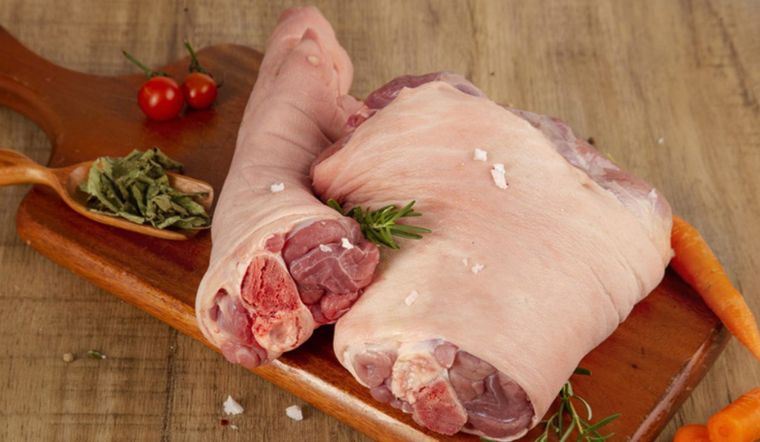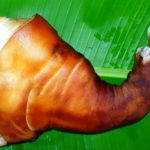Pork hocks are a versatile ingredient used in many delicious and appealing dishes. An important note is that there is a distinct flavor difference between the front and hind pork hocks. When purchasing pork hocks, which should you choose?
Nutritional Value of Pork Hocks
Pork hock meat is an excellent source of essential minerals such as calcium, collagen, vitamins B1 and B2, iron, and protein. It provides valuable nutrition to the body and effectively helps combat aging and treat insomnia.
Not only is it beneficial for health, but pork hock is also a key ingredient in numerous mouthwatering dishes, such as ‘giả cầy’ (a traditional Vietnamese pork dish), ‘nem chạo’ (Vietnamese pork meatloaf), and braised pork hock with bamboo shoots. However, to ensure the dishes are tasty and authentic, it is crucial to first select the right type of pork hock that suits the recipe.

Pork Hock Contains an Abundance of Essential Minerals for Human Health
Which Is Tastier: Front or Hind Pork Hock?
As the front hock of a pig is more active, the meat tends to be thinner, softer, and sweeter, with more tendons than the hind hock. Consequently, it is more suitable for braising, stewing, and boiling, resulting in tender meat that absorbs spices and flavors beautifully. Front hocks also generally have a smaller, more aesthetically pleasing shape.
In contrast, the hind hock, due to less movement, contains more lean meat and fat. It is ideal for making congee, stews, and stir-fries, resulting in delicious and nutritious dishes.
Therefore, depending on the recipe and your family’s taste preferences, you can decide whether to opt for the front or hind hock.
Tips for Buying Pork Hocks
The quality of pork hocks significantly influences the flavor of your dishes, so it is essential to choose wisely. The following tips will help you select the right type of pork hock for your culinary needs. Whether you are buying the front or hind hock, keep the following considerations in mind to ensure you get fresh and tasty meat:
– Look for firm meat with even muscle fibers. The cut should be dry, and the color should be natural.
– The meat should be fresh pink, devoid of any unpleasant odors, and slightly bouncy when pressed.
– Ensure the hoof is intact and not detached, as this is a sign of freshness.

Choose Your Pork Hock Depending on Your Planned Dish and Taste Preferences
Delicious Dishes Using Pork Hocks
+ Braised Pork Hock (‘Giả Cầy’):
Pork hock braised with spices like galangal, fermented rice, and northern-style shrimp paste creates a mouthwatering ‘giả cầy’ dish. The flavorful meat goes well with rice or rice vermicelli, offering a delightful meal.
+ Braised Pork Hock:
This dish features a clear, flavorful broth and tender yet firm pork hock braised to perfection with the aromatic spiciness of lemongrass. Served with rice vermicelli and crispy fried onion, it’s a tantalizing treat.
‘Bánh canh giò heo’ is a renowned delicacy in Vietnamese cuisine. The essence of the pork hock, combined with chewy-soft rice noodles, creates a lasting impression.
The Ultimate Guide to Cleaning Pork Hocks: A Quick and Easy Method to Remove Any Unpleasant Odor and Create Delicious Dishes
Pork trotter, or pig’s trotters, as they are fondly known, are a delicacy and one of the most flavorful parts of the pig. There’s a reason why this cut of meat is so popular across the globe, with countless mouth-watering dishes featuring this humble yet tasty treat. But, like any other strong-flavored meat, there’s a fine art to preparing it right and eliminating any unwanted odors. Discover the top tips and tricks to ensure your pork trotter dishes are not only delicious but also odor-free, taking your culinary creations to the next level!
The Ultimate Guide to Choosing the Perfect Ribs and Pork Hock: A Meat Connoisseur’s Dream
Pork ribs and trotters are beloved ingredients in many cuisines across the globe. They offer a unique texture and flavor that has captured the hearts of many food enthusiasts. With their versatile nature, these meaty treats can be transformed into an array of mouth-watering dishes, from sticky, finger-licking barbecue ribs to crispy, golden-brown trotters that crackle with every bite. Their popularity is undeniable, with many chefs and home cooks alike embracing their potential to create culinary masterpieces. Whether it’s a cozy family dinner or a lavish restaurant menu, pork ribs and trotters always deliver a satisfying and memorable dining experience.


































